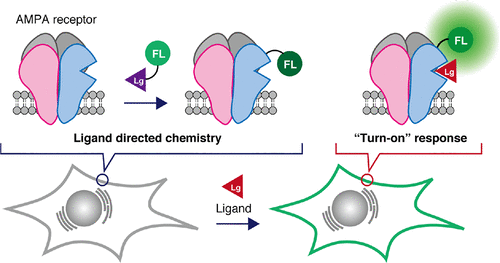当前位置:
X-MOL 学术
›
ACS Chem. Biol.
›
论文详情
Our official English website, www.x-mol.net, welcomes your
feedback! (Note: you will need to create a separate account there.)
Ligand-Directed Chemistry of AMPA Receptors Confers Live-Cell Fluorescent Biosensors
ACS Chemical Biology ( IF 3.5 ) Pub Date : 2018-02-13 00:00:00 , DOI: 10.1021/acschembio.7b01042 Shigeki Kiyonaka 1 , Seiji Sakamoto 1 , Sho Wakayama 1 , Yuma Morikawa 1 , Muneo Tsujikawa 1 , Itaru Hamachi 1, 2
ACS Chemical Biology ( IF 3.5 ) Pub Date : 2018-02-13 00:00:00 , DOI: 10.1021/acschembio.7b01042 Shigeki Kiyonaka 1 , Seiji Sakamoto 1 , Sho Wakayama 1 , Yuma Morikawa 1 , Muneo Tsujikawa 1 , Itaru Hamachi 1, 2
Affiliation

|
AMPA-type glutamate receptors (AMPARs) mediate fast excitatory synaptic transmission in the central nervous system. Dysregulation of AMPAR function is associated with many kinds of neurological, neurodegenerative, and psychiatric disorders. As a result, molecules capable of controlling AMPAR functions are potential therapeutic agents. Fluorescent semisynthetic biosensors have attracted considerable interest for the discovery of ligands selectively acting on target proteins. Given the large protein complex formation of AMPARs in live cells, biosensors using full-length AMPARs retaining original functionality are ideal for drug screening. Here, we demonstrate that fluorophore-labeled AMPARs prepared by ligand-directed acyl imidazole chemistry can act as turn-on fluorescent biosensors for AMPAR ligands in living cells. These biosensors selectively detect orthosteric ligands of AMPARs among the glutamate receptor family. Notably, the dissociation constants of agonists and antagonists for AMPARs were determined in live cells, which revealed that the ligand-binding properties of AMPARs to agonists are largely different in living cells, compared with noncellular conditions. We also show that these sensors can be applied to detecting allosteric modulators or subunit-selective ligands of AMPARs. Thus, our protein-based biosensors can be useful for discovering pharmaceutical agents to treat AMPAR-related neurological disorders.
中文翻译:

AMPA受体的配体定向化学赋予活细胞荧光生物传感器
AMPA型谷氨酸受体(AMPAR)在中枢神经系统中介导快速兴奋性突触传递。AMPAR功能失调与多种神经系统疾病,神经退行性疾病和精神疾病有关。结果,能够控制AMPAR功能的分子是潜在的治疗剂。荧光半合成生物传感器对选择性作用于靶蛋白的配体的发现引起了相当大的兴趣。鉴于活细胞中AMPAR的大型蛋白质复合物形成,使用保留原始功能的全长AMPAR的生物传感器是药物筛选的理想选择。在这里,我们证明了通过配体导向的酰基咪唑化学制备的荧光团标记的AMPAR可以充当活细胞中AMPAR配体的开启荧光生物传感器。这些生物传感器选择性地检测谷氨酸受体家族中AMPAR的正构配体。值得注意的是,在活细胞中测定了AMPAR激动剂和拮抗剂的解离常数,这表明与非细胞条件相比,在活细胞中AMPAR与激动剂的配体结合特性差异很大。我们还表明,这些传感器可以应用于检测AMPAR的变构调节剂或亚基选择性配体。因此,我们基于蛋白质的生物传感器可用于发现治疗AMPAR相关神经系统疾病的药物。这表明与非细胞条件相比,在活细胞中AMPAR与激动剂的配体结合特性有很大不同。我们还表明,这些传感器可以应用于检测AMPAR的变构调节剂或亚基选择性配体。因此,我们基于蛋白质的生物传感器可用于发现治疗AMPAR相关神经系统疾病的药物。这表明与非细胞条件相比,AMPAR与激动剂的配体结合特性在活细胞中有很大差异。我们还表明,这些传感器可以应用于检测AMPAR的变构调节剂或亚基选择性配体。因此,我们基于蛋白质的生物传感器可用于发现治疗AMPAR相关神经系统疾病的药物。
更新日期:2018-02-13
中文翻译:

AMPA受体的配体定向化学赋予活细胞荧光生物传感器
AMPA型谷氨酸受体(AMPAR)在中枢神经系统中介导快速兴奋性突触传递。AMPAR功能失调与多种神经系统疾病,神经退行性疾病和精神疾病有关。结果,能够控制AMPAR功能的分子是潜在的治疗剂。荧光半合成生物传感器对选择性作用于靶蛋白的配体的发现引起了相当大的兴趣。鉴于活细胞中AMPAR的大型蛋白质复合物形成,使用保留原始功能的全长AMPAR的生物传感器是药物筛选的理想选择。在这里,我们证明了通过配体导向的酰基咪唑化学制备的荧光团标记的AMPAR可以充当活细胞中AMPAR配体的开启荧光生物传感器。这些生物传感器选择性地检测谷氨酸受体家族中AMPAR的正构配体。值得注意的是,在活细胞中测定了AMPAR激动剂和拮抗剂的解离常数,这表明与非细胞条件相比,在活细胞中AMPAR与激动剂的配体结合特性差异很大。我们还表明,这些传感器可以应用于检测AMPAR的变构调节剂或亚基选择性配体。因此,我们基于蛋白质的生物传感器可用于发现治疗AMPAR相关神经系统疾病的药物。这表明与非细胞条件相比,在活细胞中AMPAR与激动剂的配体结合特性有很大不同。我们还表明,这些传感器可以应用于检测AMPAR的变构调节剂或亚基选择性配体。因此,我们基于蛋白质的生物传感器可用于发现治疗AMPAR相关神经系统疾病的药物。这表明与非细胞条件相比,AMPAR与激动剂的配体结合特性在活细胞中有很大差异。我们还表明,这些传感器可以应用于检测AMPAR的变构调节剂或亚基选择性配体。因此,我们基于蛋白质的生物传感器可用于发现治疗AMPAR相关神经系统疾病的药物。











































 京公网安备 11010802027423号
京公网安备 11010802027423号